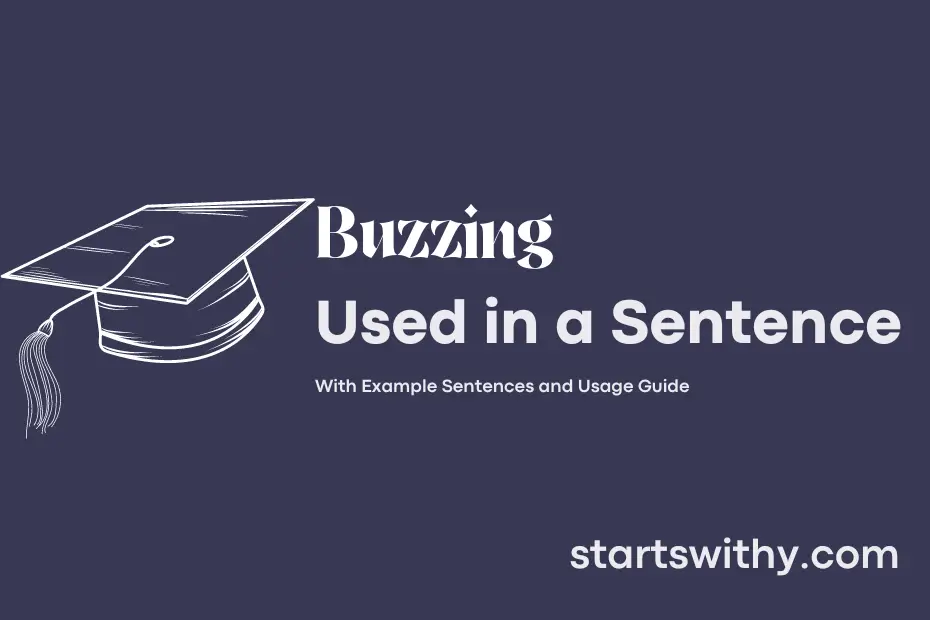Have you ever noticed how certain words can create a vivid picture or feeling in your mind? One such word that can paint a lively scene is “buzzing.”
When something is buzzing, it is filled with a lively or energetic activity, often making a humming or vibrating sound. This word can be used to describe a variety of situations or atmospheres that are bustling with excitement or energy.
7 Examples Of Buzzing Used In a Sentence For Kids
- Buzzing bees are busy collecting nectar from flowers.
- We can hear the buzzing sound of the bees in the garden.
- The buzzing of the mosquitoes can be annoying at night.
- The buzzing of a fly is different from that of a bee.
- Do you know why bees make a buzzing sound?
- When flowers bloom, bees start buzzing around them.
- Be careful not to disturb the buzzing insects while playing outside.
14 Sentences with Buzzing Examples
- Buzzing with excitement for the upcoming college festival.
- Unable to concentrate on studying with all the buzzing noise outside.
- The classroom was buzzing with discussions about the upcoming exams.
- Buzzing with energy after having a cup of coffee during the late-night study session.
- The library was buzzing with students preparing for their exams.
- Buzzing with curiosity to explore the new clubs and activities offered on campus.
- The canteen was buzzing with students sharing stories from their summer vacations.
- Buzzing with anticipation for the results of the latest campus placement drive.
- The campus was buzzing with excitement for the upcoming sports tournament.
- Buzzing with ideas for the next college project.
- The lecture hall was buzzing with students discussing the latest research findings.
- Buzzing with enthusiasm for joining a new internship program.
- The college WhatsApp group was buzzing with messages about the upcoming cultural fest.
- Buzzing with motivation to excel in academics and co-curricular activities.
How To Use Buzzing in Sentences?
To buzz means to make a low, continuous humming or buzzing sound. When using buzzing in a sentence, consider the following tips:
-
Subject-Verb Agreement: Make sure that the subject of the sentence agrees with the verb. For example, “The bees were buzzing around the flowers” (plural subject) vs. “The fly is buzzing near the window” (singular subject).
-
Tense: Pay attention to the tense of the sentence. For instance, “The phone is buzzing with notifications” (present continuous tense) vs. “Yesterday, the room buzzed with excitement” (simple past tense).
-
Context: Provide context in the sentence to make it clear what is buzzing. For example, “The mosquito kept buzzing in my ear all night” specifies what is making the sound.
-
Adverbs: You can enhance the sentence by adding adverbs that describe how the buzzing sound is being made. For instance, “The fluorescent light constantly buzzes in my office” or “The cicadas loudly buzzed in the trees.”
-
Punctuation: Use appropriate punctuation, such as quotation marks to indicate reported speech or onomatopoeia. For example, “I could hear the bees ‘buzzing’ as I walked through the garden.”
Practice using buzzing in sentences to improve your understanding and fluency in expressing the sound of buzzing in various contexts.
Conclusion
In conclusion, the buzzing sound is typically described as a continuous, low, humming noise that can be heard in the background. Examples of sentences with the keyword “buzzing” include “The bees were buzzing around the flowers” and “The electronics emitted a loud buzzing noise.” This word is commonly used to convey the sound of insects, electronic equipment, or any other source that produces a persistent humming or vibrating noise.
Whether it’s the gentle buzzing of bees gathering nectar or the annoying buzzing of a faulty appliance, this word effectively captures the essence of a continuous, monotonous sound. By using “buzzing” in sentences, one can vividly describe auditory experiences and create a more engaging narrative for the reader.



